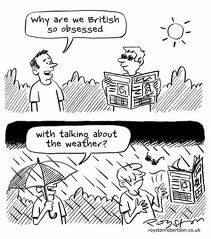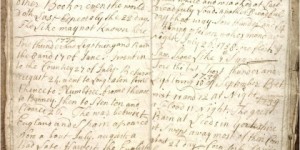Professor Georgina Endfield, University of Nottingham
PI of Weather Extremes, funded under AHRC Care for the Future: Thinking Forward through the Past
In 1952, climatologist Gordon Manley suggested that “if a census were taken of common topics of conversation amongst British people, it is very probable that the weather would take first place” (Manley, 1952:13). This statement is probably as true today as it was over sixty years ago, and while in no way being unique in this, it is fair to say that the British have a something of an obsession with the weather.
 Yet the weather has arguably become an even more popular topic of conversation in recent years. In part, this is a function of narratives highlighting the apparently looming, apocalyptic climate changes that global society faces, but it may also be a result of rising concern over the impacts of anomalous, ‘extreme’ weather events such as droughts, floods, storm events and unusually high or low temperatures. While social and economic systems have generally evolved to accommodate some deviations from “normal” weather conditions, this is rarely true of extremes. Such events, therefore, can have the greatest and most immediate social and economic impact of all climate changes, exemplified most recently in the UK by the storms of January and February 2014.
Yet the weather has arguably become an even more popular topic of conversation in recent years. In part, this is a function of narratives highlighting the apparently looming, apocalyptic climate changes that global society faces, but it may also be a result of rising concern over the impacts of anomalous, ‘extreme’ weather events such as droughts, floods, storm events and unusually high or low temperatures. While social and economic systems have generally evolved to accommodate some deviations from “normal” weather conditions, this is rarely true of extremes. Such events, therefore, can have the greatest and most immediate social and economic impact of all climate changes, exemplified most recently in the UK by the storms of January and February 2014.
Yet extreme weather, our fascination with it and more particularly our eagerness to write and talk about it, are of course far from unprecedented. As popular weather writer Philip Eden notes, “Bad weather has always been part of the British scene” (2005: vii). In our 3 year project, we are drawing on a wide range of historical records and conducting community based oral histories to investigate the timing and implications of- and responses to extreme weather in a range of spatial contexts across the UK, dating back to the late seventeenth century.
Different regional circumstances, particular physical conditions, an area’s social and economic activities and embedded cultural knowledges, norms, values, practices and infrastructures all affect the impacts of and responses to extreme weather. The way in which an extreme event is experienced and perceived in turn determines whether it becomes inscribed into the memory of a community or an individual in the form of oral history, ideology, custom, narrative, artefact, technological and physical adaptation, including adaptations to the working landscape and built environment. These different forms of remembering and recording the past represent central media through which information on past events is curated, recycled and transmitted across generations and into the future.
In our project we are tapping into these different forms of remembering and recording. The archive has been the most obvious place to start and as our own project blog is demonstrating, the many regional archival collections we are exploring are yielding some fascinating insights into the socio- economic, cultural and environmental implications of past extremes. We are drawing on a very wide range of sources. Although official meteorological observations rarely extend back beyond the mid nineteenth century, climate and weather have long been the subjects of private narratives, diaries, chronicles and sermons dating back to the later seventeenth and eighteenth centuries. A very diverse group of people were involved in observing and recording weather in this period, either in networks or independently, including farmers, gentlemen scientists, physicians, sea captains, religious figures and naturalist curates, university professors and travellers. Over and above using such sources for identifying extreme weather and its impacts, our work is revealing much about such observers, the way in which they recorded the weather and what form their observations took, as well as insight into their motivations for weather observation. In the earliest records, emphasis was often placed on the qualitative, narrative framing of unusual or extreme events that disrupted everyday life. From the mid to late eighteenth century, more quotidian recording practices were adopted whereby people collated daily local weather records, based on their own personal observations, though extreme events tended to be more noteworthy and are often described in detail.  There are very many such records- too many to consider here- but one example is John Harrison’s notebook, now held in the Derbyshire Records Office in Matlock. Written when he was 20 years old and from his home town of Belper, his diary represents in his own words a “hemerologium”, a “calendar of events” or, a “Book of Remarks”. He recorded his observations between 1734 and 1747 and throughout this period, in addition to recording regional. national and international news he documents the timing, frequency and impacts of storm events and unusual atmospheric phenomena including visual phenomena, eclipses, comets and instances of the aurora borealis. Of particular interest for our project are his detailed weather observations during “the great frost” or “the great freeze” which was experienced across much of northern Europe between 1739 and 1744.
There are very many such records- too many to consider here- but one example is John Harrison’s notebook, now held in the Derbyshire Records Office in Matlock. Written when he was 20 years old and from his home town of Belper, his diary represents in his own words a “hemerologium”, a “calendar of events” or, a “Book of Remarks”. He recorded his observations between 1734 and 1747 and throughout this period, in addition to recording regional. national and international news he documents the timing, frequency and impacts of storm events and unusual atmospheric phenomena including visual phenomena, eclipses, comets and instances of the aurora borealis. Of particular interest for our project are his detailed weather observations during “the great frost” or “the great freeze” which was experienced across much of northern Europe between 1739 and 1744.
From the 1700s, there is a greater availability of local, regional and national newspapers, which represent an important source of high resolution climate and weather data which also provide detailed accounts of the ramifications and implications of unusual or extreme events. Alongside these more direct sources of information, however, there are other historical documentary sources travel accounts and descriptions, legal documents, poems and literary sources, crop and tax records, as well as maps, paintings and images, all of which can contain potentially useful information about periods of anomalous and extreme climate over the historical period.
We are also exploring the history of extremes and associated implications through personal testimony, oral histories and behaviour. Many folk and rural narratives and proverbs regarding the weather are based on familiarity with long-term climate variability, or what historian Katherine Anderson has referred to as “weather wising”. Local weather, and departures from perceived norms in this respect, can also become inscribed into everyday practices, including farming, gardening and a variety of domestic and recreation pursuits, and can also be embedded in the design and construction of vernacular buildings, while extreme events that resulted in trauma, such as flood events, and the epigraphic records of such events, can also become a focus of community memorial and mourning. All such examples of weather’s cultural inscription are offering insight into the ways in which people have documented, recall and remember particular types of weather.
People’s nostalgia about past weather events or weather conditions offers another area of research which we will be pursuing specifically through our oral history work. This aspect of the project brings an interesting challenge- a subject of further study in itself – for we do not have to have a lived experience of the past to feel nostalgia for it. Rather there is a distinction between what has been referred to as ‘real’ nostalgia and nostalgia for some remembered previous time and a so-called ‘stimulated’ nostalgia – a form of vicarious nostalgia evoked from stories, images and possessions or received wisdoms (Baker ad Kennedy, 1994). It is also important to remember that our weather memories depend heavily on idealized stereotypes of seasonal conditions. As Rayner (2009) notes, “we still expect to see snowmen on Christmas cards”, though white Christmases are in fact very rare. Anything deviating from stereotypical norms thus become unusual and in some cases extreme.
There is of course a value to this historical research beyond unearthing very many fascinating and engaging accounts, memories, narratives and stories. Investigating the different ways in which people document, remember and recall past events, from eighteenth century personal diaries through to 21st century tweets and Flickr images, allows us to identify the type of events that become inscribed into the social, cultural and infrastructural fabric of a community and, through comparison with available instrumental weather records, those events that do not. This issue of memory and remembering and identifying how and why certain weather events are remembered while others are forgotten, is one of the central issues within the Care for the Future theme. We hope to be able to identify the way in which weather events provide a metacognitive role in memory and to highlight the degree to which weather events per se, relative to other events, including those associated with trauma, assist in memory making. This is important for several reasons. First, recent research is suggesting that cultural memories, experiences and knowledge of past weather and weather events, whatever form these may take, can condition how people comprehend and respond to the problems of risk and uncertainty with respect to climate change (Lazarus and Peppler, 2013). Knowledge of past events may thus serve an important orientating function with respect to adaptability to future change, thereby again feeding into key questions raised through Care for the Future.
Second, such local, ‘experiential’ weather records and memories in turn are assuming new importance as legitimate sources of climate knowledge in themselves and communication of climate change risk is thought to be far more effective and appropriately targeted if it takes into account these relevant personal and vicarious experiences in the form of narrative, memories and anecdotes (Marx et al., 2007). The reconstruction of regionally specific climatic histories and historical extreme weather events, and investigations of the memories of and social responses to these events are, therefore, of crucial significance if we are to be able to assess how people in different contexts might be affected by, might comprehend and respond to future events.
Further details about the project can be found at:
www.nottingham.ac.uk/weatherextremes
blogs.nottingham.ac.uk/weatherextremes
Twitter @weather_extreme
Like us on Facebook
References and further reading
Anderson, K. (2010) Predicting the weather: Victorians and the science of meteorology. University of Chicago Press
Baker, S.M and Kennedy, P.F. (1994) Death by nostalgia: a diagnosis of context-specific cases. Advances in Consumer Research 21 (1): 169-176
Eden, P (2005) Change in the weather. Continuum Books, London
Lazarus, H. and Peppler, R (2013) Ways of knowing: traditional knowledge as key insight for addressing environmental change, theme introduction, Weather, Climate and Society special collection (2013) http://journals.ametsoc.org/page/Ways [accessed 20/11/2013].
Manley, G (1952) Climate and the British Scene. Collins New Naturalist Series, No. 22
Marx, S.M., Weber, E.U., Orlove, B.S., Leiserowitz, A., Krantz, D.H., Roncoli, C., Phillips, J. (2007) Communication and mental processes: experiential and analytic processing of uncertain climate information. Global Environmental Change 17, 47–58
Rayner, S (2003) “Domesticating Nature: Commentary on the Anthropological Study of Weather and Climate Discourse,” in Strauss and Orlove, Weather, Climate, Culture (cit. n. 17), 277–90, on 281

